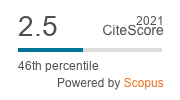DELAY FAULT MODELS AND METRICS
Abstract
The delay fault testing has become an important part of the overall test development process. But delay fault testing is not so mature as stuck-at fault testing. The paper surveys various delay fault models, their advantages and limitations. The current trends in test pattern generation for delay faults are analyzed, too. The test pattern gene-ration is directly related to the coverage metrics. The coverage metrics mainly tend to evaluate the quality of path delay fault patterns. The focus is made on two groups of the metrics: non-enumeratve methods and statistical methods. The non-enumerative methods rely on the traditional counting of the paths, which are tested under robust, non-robust, or functional sensitization criteria. The statistical methods relate their computations to the parameters under process variation. The basis of the methods is their weakness. There is still no accepted common metric to evaluate the quality of the delay test patterns. On that base, the paper suggests a new approach to the evaluation of the quality of the delay test patterns. This approach stands on the new term – test confidence level (the ground level, the first level, the second level and etc.). The procedure of the evaluation of test quality for delay faults is presented, too.
Downloads
Published
Issue
Section
License
Copyright terms are indicated in the Republic of Lithuania Law on Copyright and Related Rights, Articles 4-37.





